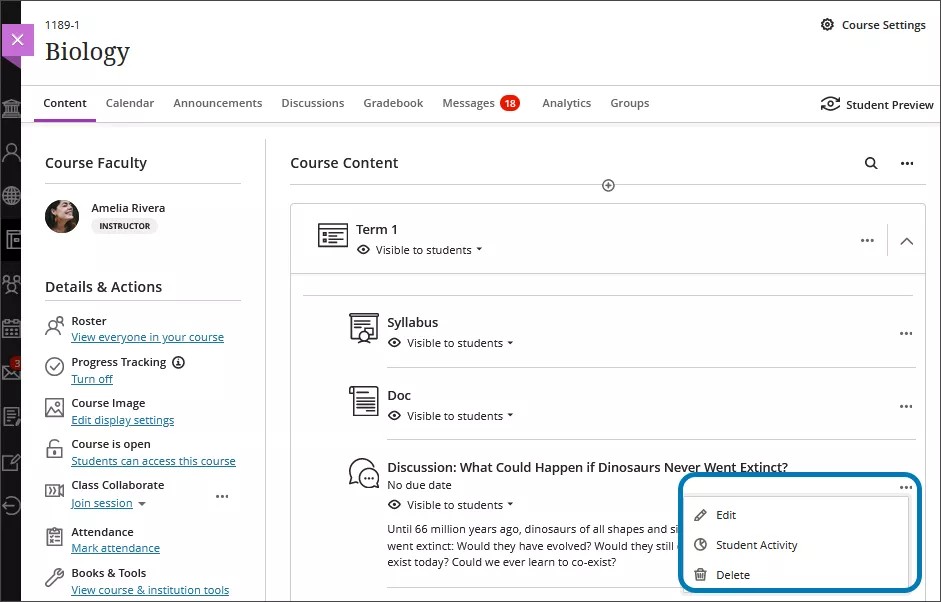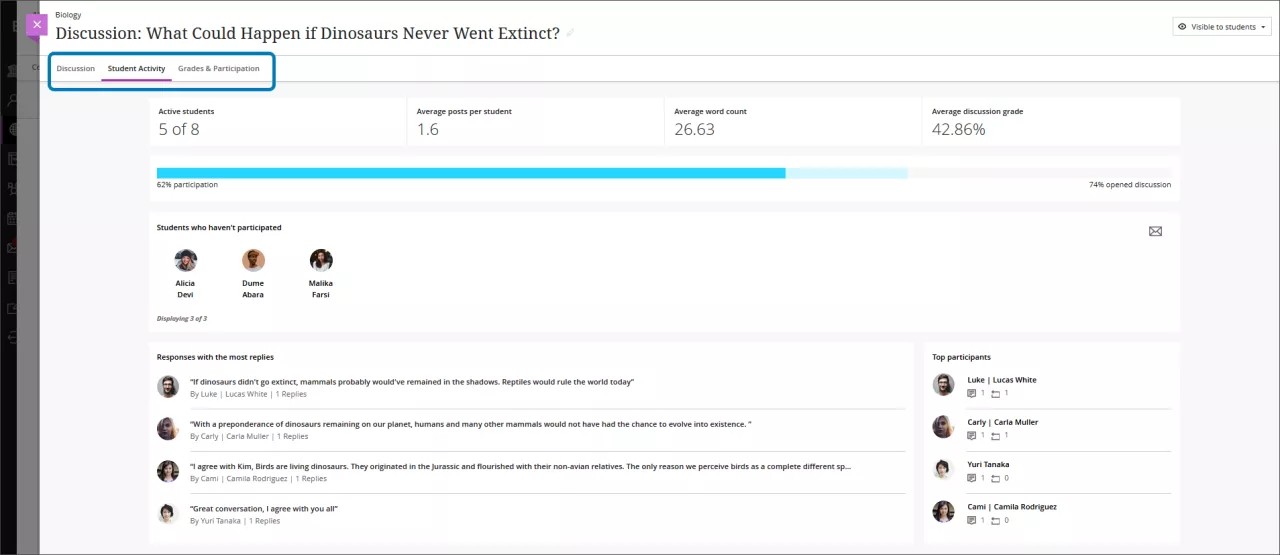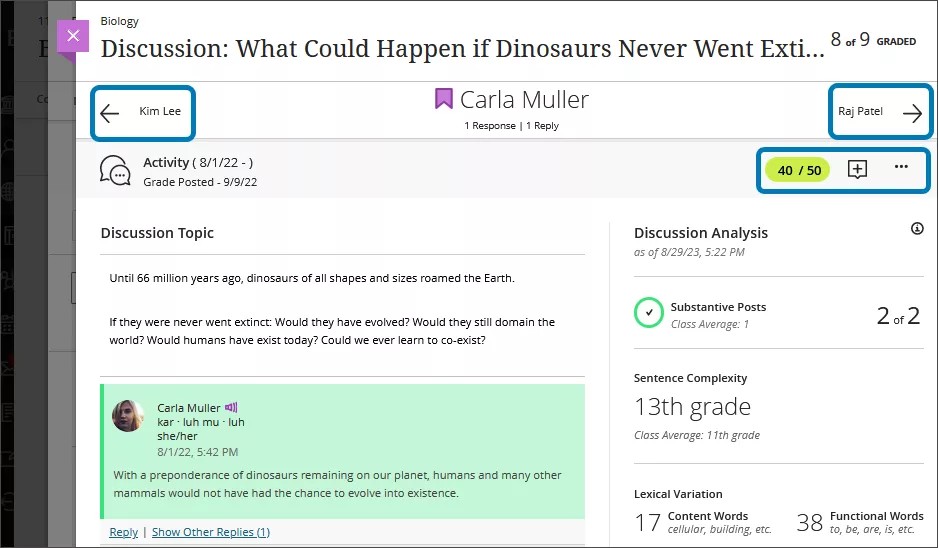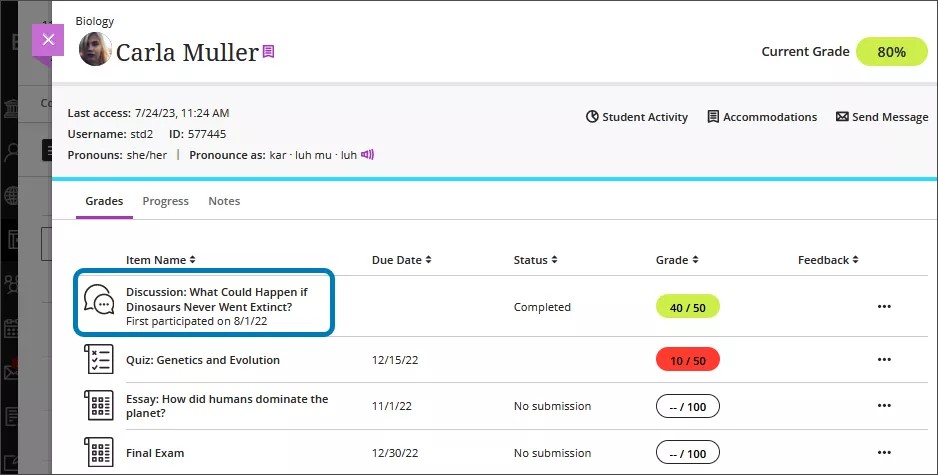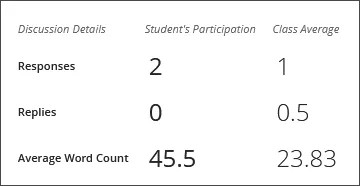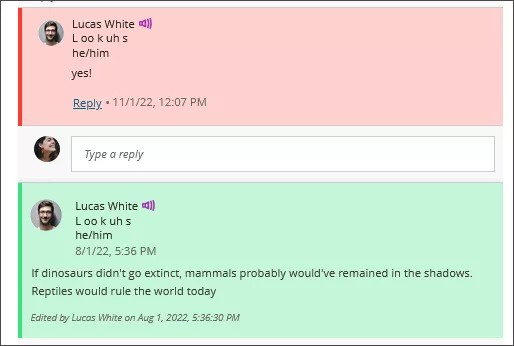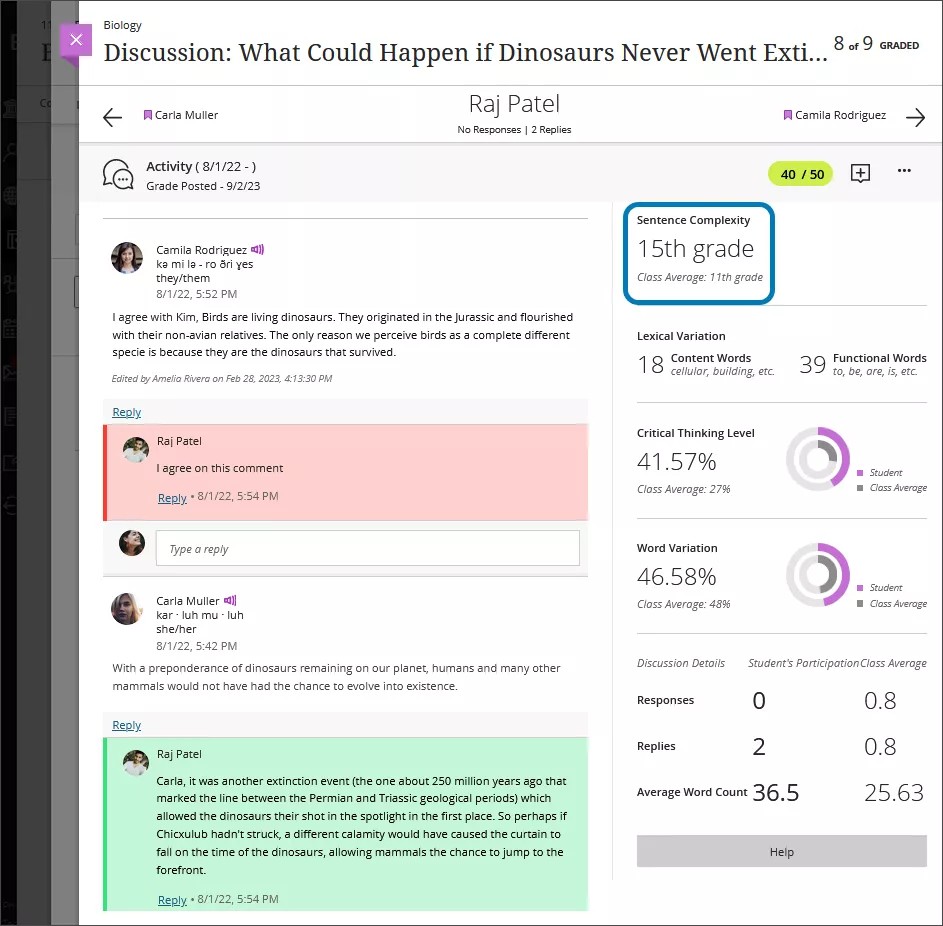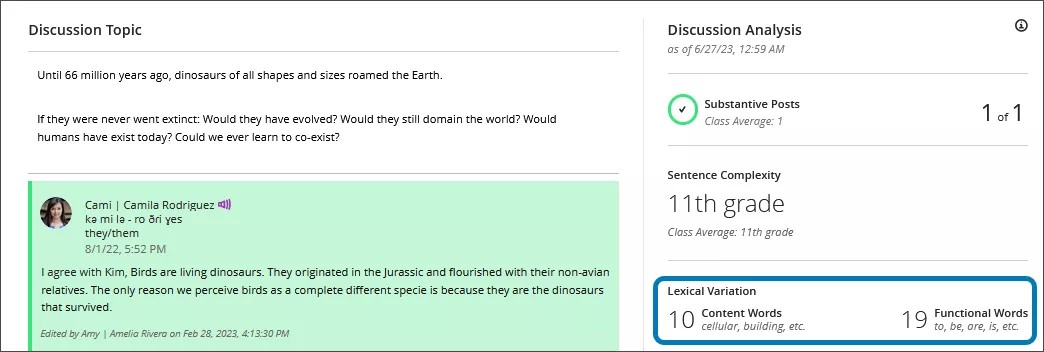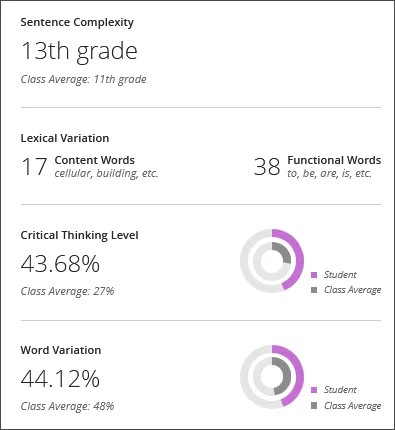About discussion analytics and student activity
Students report that satisfaction with online courses relates to instructor presence. Discussions are an easy way to engage students in your courses. Discussions broaden communication and foster strong connections among the group and with you.
When you add a discussion activity, you may have these goals:
- Encourage participation
- Engage your students
- Read all the responses
- Assign grades
If you have many students, these goals become challenging. In courses with many discussions or high discussion participation, you may find you can't gauge student participation or gather enough details. Some instructors choose to award credit for completion instead of in-depth grading. Discussion analysis in Blackboard Learn simplifies grading, so you have more time to engage with students.
Discussion analysis provides an in-depth look at each student’s discussion participation using multiple metrics. These performance-based insights show you which students may need help or are out of the normal range of participation. Our discussion analysis algorithm focuses on a student's content and provides details to help you evaluate participation. We've automated the word count and introduced features that address the meaningfulness of the writing.
You shouldn’t use discussion analysis metrics as your sole guideline for grading. Discussion analysis algorithms are meant to inform your decisions, but can’t replace reading student responses.
Individual level discussion analysis only appears for graded discussions.
Topics on this page include:
Watch a video about Discussion Analysis
Class level discussion analysis and student activity
You can access discussion analysis for the entire class by selecting the Student Activity tab on the discussion’s page. You can also access discussion analysis from the Course Content page by selecting Student Activity in the More options menu for a discussion.
If it’s a group discussion, information is displayed by the group and you can select which group to view from the Group menu at the top.
The Student Activity page summarizes your class’s discussion participation. You can view:
- Number of active students out of the entire class
- Average posts per student
- Average word count
- Average discussion grade
- Percentage of students who’ve participated
- Percentage of students who’ve opened the discussion
There’s a section displaying students who haven’t participated. You can select their name to send them a message about their participation, or message the entire group of non-participants by selecting the envelope icon to the right.
Responses with the most replies are displayed so that you can view what responses students engaged with the most. Select the response to go directly to the discussion thread.
Top participants are displayed on the page. Select the student to go to their individual discussion analysis page.
Individual level discussion analysis
Select the Grades & Participation tab on the discussion’s page to see individual discussion analysis. Select a student’s name to go to their discussion analysis.
You can select the next or previous arrows at the top to go to another student’s discussion analysis. You can also grade or give feedback from this same page.
You can also access individual discussion analysis by selecting the discussion on the Grades tab of the Student Overview. Visit the “Student Overview” topic for more information about the Student Overview feature.
You can go directly to the individual discussion analysis for any of the top participants who appear on the discussion’s Student Activity tab.
Discussion details
You can view a summary of student participation along with the discussion analysis metrics. The summary includes the number of a student’s responses, replies, and average word count in comparison to the class average.
Types of discussion analysis metrics
Discussion analysis provides a closer look at how your students participate in discussions. As you grade a discussion, you can use these metrics to help determine a grade:
- Substantive posts: The number of responses and replies that contribute to the discussion's development.
- Sentence complexity: Average grade level readability for the student's posts.
- Lexical variation: Count of content words and functional words. Content words support the student's ideas, while functional words support proper grammar.
- Critical thinking level: Percentage of words and phrases within a student's total posts that demonstrate critical thinking.
- Word variation: Percentage of unique words in a student's responses and replies.
- Discussion details: responses, replies, and average word count for each student and the class average
New posts and replies have a purple background.
Types of discussion analysis metrics: Substantive posts
Substantive posts are the number of responses or replies that contribute to the discussion's development. Discussion analytics calculates if a post is substantive based on word count and word variety.
A substantive post contains sentences that establish or support a student's position or ask thoughtful questions. These posts also show critical thinking or advanced composition.
Non-substantive posts may be short or underdeveloped. For example, a simple "Yes" or "No" reply to a discussion prompt isn't substantial. Students need to expand on their answers and explain their positions to make their responses or replies substantial.
Substantive posts are highlighted in green and non-substantive posts are highlighted in red. You can view a count of a student’s total substantive posts and compare them to the class average. You can use the number of substantive posts to gauge how much your students are actively participating in a discussion rather than leaving non-substantive replies.
Types of discussion analysis metrics: Sentence complexity
Sentence complexity is measured by the number of sentences, words, and syllables in each response. We look at the complexity of words and how often the words are used. This measurement is a linguistic standard called Flesch-Kincaid. The complexity of each student’s total posts is represented by a grade level from 1st grade to 16th grade, measured by the standards of the United States educational system. Content with a Flesch-Kincaid grade level of 10 should be easily understood by a person in 10th grade.
For example, a student who responds to a post with several complicated sentences will have a high Flesch-Kincaid grade level.
In comparison, a student who responds with two short sentences that have simple syntax will have a low Flesch-Kincaid grade level.
Sentence length is weighted more highly than word length. A long sentence with simple vocabulary may score higher on the Flesch-Kincaid grade level than a short sentence with advanced vocabulary. You can use the Flesch-Kincaid grade level as an overview of how much effort a student’s putting into discussion. However, you should still review the actual content of a student’s posts before making a grading decision.
For example, the following sentence has a Flesch-Kincaid grade level of 8th grade:
When I entered the room, I immediately went to the dinner table and ate my dinner.
In contrast, the following sentence has a Flesch-Kincaid grade level of 7th grade:
I satiated my hunger with a fulsome repast.
Types of discussion analysis metrics: Lexical variation
Lexical variation calculates the substance of a student's posts or replies based on how many content words a student is using in comparison to function words. Content words carry meaning or ideas, whereas functional words make the sentence work with proper grammar. Prepositions, conjunctions, pronouns, and articles are functional words.
Think of functional words as the glue that holds a student's response together. Function words may not have substantial meaning themselves. Content words show a student's feelings or thoughts about your prompt.
In the above example screenshot, Cami has responded with several sentences that have a lot more function words than content words. Cami wrote:
I agree with Kim, birds are living dinosaurs. They originated in the Jurassic and flourished with their non-avian relatives. The only reason we perceive birds as a completely different species is because they are the dinosaurs that survived.
Dinosaurs, birds, and Jurassic are content words. Phrases used to link ideas, such as “in the” or “as a,” are not counted as lexical variation.
Types of discussion analysis metrics: Critical thinking
Critical thinking measures the number of words and phrases within a student's total posts that demonstrate critical thinking as a percentage. Twelve dictionaries are used to identify the words, which then fall into one of the weighted categories of critical thinking:
- Argue a position
- Disagreement
- Provide commentary
- Agreement
- Negotiation
- Evaluation
- State a position
- Hypothesis
- Provide experience
- Cite literature
How we measure critical thinking
The words and phrases in each category of the twelve dictionaries used in the student’s response are combined and then weighted. Disagreement is weighted more than agreement.
Critical thinking is represented visually to show each student's score compared to the class average. Students with an above average critical thinking level tend to score well in other areas of discussion analytics, such as the Flesch-Kincaid grade level and lexical variation.
Factors that contribute to the critical thinking level:
- Empirical research shows disagreeing displays a higher level of critical thinking than agreeing. In a discussion, the statement "I agree with John" receives a score of 0.113, while "I disagree with John" receives a score of 0.260.
- If students summarize a passage but add no opinion or argument, they score lower than others who argue a position.
- If students cite literature, they receive a lower score than students who offer a hypothesis.
Types of discussion analysis metrics: Word variation
Word variation measures the number of unique words in a student's response as a percentage. A higher percentage of unique words can show that the student's response contains multiple ideas and significantly supports a position. A higher percentage can also show that a student engages classmates to think about other perspectives.
You can compare the student's percentage to the class average.
Hide discussion analysis
To hide discussion analysis, open the menu and select Hide Discussion Analysis.
Why don't I see data?
At least one discussion must be graded before discussion analysis is generated. Discussion analysis refreshes nightly for active discussions. The data won't update if there's no new discussion activity on a given day. You'll see data in the Discussion Analysis panel if the student has participated within the last four months.
Only instructors and graders can see the discussion analysis.
